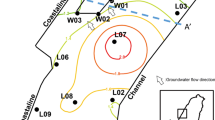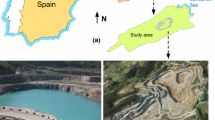Abstract
Three aquifer systems as deep, middle, and shallow were identified in the Kazan trona ore deposit area. The flow conditions and the interaction between various layers were conceptualized into a site hydrogeological model. Each aquifer system was hydraulically and chemically characterized and represented in a numerical groundwater model. The resulting model has been calibrated under steady-state and transient conditions using available data. The flow model was used in conjunction with a three-dimensional solute transport model to assess the impacts of the pilot well solution mining of the trona deposit on groundwater resources during operation and post-operation periods. The results of operation period indicate that, even under the worse conditions (50 times increase in vertical hydraulic conductivity due to subsidence), ion contribution from the mine area with 118,000 mg/l maximum concentration would be about 58 mg/l into the deep aquifer system. This contribution is about 1.45% of the existing concentration (4,000 mg/l) in the deep aquifer. After 1,000 years of post-operation period, ion contribution from the mine area with maximum 119,000 mg/l concentration would be about 205 mg/l into the deep aquifer under extremely worse conditions. This contribution is about 5–20% of present concentrations in the deep aquifer. Retardation factors, which were not considered during model simulations would decrease the predicted concentrations. It is concluded that pilot well solution mining of the trona deposit would not have significant impact on the quality of groundwater resources in the overlying aquifers.











Similar content being viewed by others
References
Agapito Associates Inc. (2002) Subsidence evaluation for the Kazan Project, Rio tinto. Grand Junction, Colorado
Bouwer H, Rice RC (1976) A slug test for determining hydraulic conductivity of unconfined aquifers with completely or partially penetrating wells. Water Resour Res 12:423–428
Camur MZ, Er C, Yazicigil H (2007) Modeling of lithology induced chemical anomalies in the aquifer systems of the Kazan trona deposit area, Ankara, Turkey. Environ Geol. doi:10.1007/s00254-007-0862-z
Cooper HH, Jacob CE (1946) A generalized graphical method for evaluating formation constants and summarizing well field history. Trans Am Geophys Union 27:526–534
Harbaugh AW, McDonald MG (1996) User’s documentation for MODFLOW-96, an update to the U.S. Geological Survey modular finite-difference ground-water flow model. U.S. Geological Survey Open-File Report 96-485, 56 p
Hsieh PA, Freckleton JR. (1993) Documentation of a computer program to simulate horizontal-flow barriers using the U.S. Geological Survey’s modular three-dimensional finite-difference ground-water flow model. U.S.Geological Survey Open-file Report 92-477, 32 p
Jacob CE, Lohman SW (1952) Nonsteady flow to a well of constant drawdown in an extensive aquifer. Trans Am Geophys Union 33:559–569
Neuman SP (1990) Universal scaling of hydraulic conductivities and dispersivities in geologic media. Water Resour Res 26:1749–1758
Toprak V, Rojay B (2000) Geological baseline study for the Kazan Soda Project Area, Ankara, Turkey. Middle East Technical University
Toprak V, Rojay B (2001) Geological investigation in Kazan Soda Project Area, Ankara, Turkey. Middle East Technical University
Varol B (2002) Sedimentological and mineralogical studies of core samples Kazan Trona Project Ankara-Turkey. RioTinto Report
Zheng C, Wang PP (1999) MT3MS: A modular three-dimensional multispecies transport model for simulation of advection, dispersion and chemical reactions of contaminants in groundwater systems. University of Alabama, U.S.A
Acknowledgments
This material is based on work funded by Riotur Mining Inc., a wholly owned subsidiary of the Rio Tinto through contract No. 129102 to SRK Consulting and Engineering Inc. Any opinions, findings, conclusions, or recommendations expressed in this publication are those of the authors and do not necessarily reflect the views of Riotur or Rio Tinto. We thank to administrators and staff members of Rio Tinto and its subsidiary Riotur for the support they have provided during our studies. The studies would not have been possible without the ready support from RioTinto, especially Kenneth H. Haddow, E. Kemal Yildirim, Tamer Talu, Cengiz Y. Demirci, and Faruk Suluki. We would like to thank John Campbell for his detailed review on an earlier draft of this work. We would also like to acknowledge the assistance of Uygar Duru in the field and Bahar Tuzcu in the office.
Author information
Authors and Affiliations
Corresponding author
Rights and permissions
About this article
Cite this article
Yazicigil, H., Er, C., Ates, J.S. et al. Effects of solution mining on groundwater quality in the Kazan trona field, Ankara-Turkey: model predictions. Environ Geol 57, 157–172 (2009). https://doi.org/10.1007/s00254-008-1291-3
Received:
Accepted:
Published:
Issue Date:
DOI: https://doi.org/10.1007/s00254-008-1291-3




